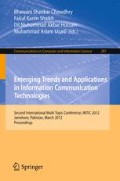Abstract
In this paper, we address the problem of locating a disease gene using a new Haplotype Segment Algorithm based on distance/similarity measures. We developed a novel approach to identify the set of associated marker alleles in the form of haplotype segments. We measure the distance of haplotype segments in cases and controls. We find the two haplotype segments in cases which have least distance than controls and observe that the disease location lies between these two haplotype segments. Haplotype Segment Algorithm performs the similarity analysis of haplotypes and finds the location of a disease gene using various distance/similarity measures. Haplotype Segment Algorithm uses the similarity or distance measures so this algorithm has the capability to reduce or delete the noise from the segments and finds a precise location of disease gene. The new algorithm detects the disease gene even if there exists 5% mutant chromosomes in the human genome. We applied new algorithm on simulated datasets and find the location of disease gene very close to the true simulated location. We also assessed the performance of Haplotype Segment Algorithm on a real dataset called Friedreich Ataxia’s dataset in detecting a disease gene location and find the consistent results.
Access this chapter
Tax calculation will be finalised at checkout
Purchases are for personal use only
Preview
Unable to display preview. Download preview PDF.
References
Li, J., Jiang, T.: Haplotype-based linkage disequilibrium mapping via direct data mining. Bioinformatics 21, 4384–4393 (2005)
Toivonen, H., Onkamo, P., Vasko, K., Ollikainen, V., Sevon, P., Mannila, H., Herr, M., Kere, J.: Data mining applied to linkage disequilibrium mapping. American Journal of Human Genetics 67, 133–145 (2000)
Toivonen, H., Onkamo, P., Vasko, K., Ollikainen, V., Sevon, P., Mannila, H., Kere, J.: Gene Mapping by Haplotype Pattern Mining. In: IEEE Proc. Int’l Symposium Bioinformatics and Biomedical Engineering (BIBE), pp. 99–108 (2001)
Besenbacher, S., Pedersen, C.N., Mailund, T.: A fast algorithm for genome-wide haplotype pattern mining. In: Proc. of Int’l Conf. on Bioinformatics, Beijing, China (2009)
Lin, L., Wong, L., Leong, T., Lai, P.: LinkageTracker: A Discriminative Pattern Tracking Approach to Linkage is equilibrium Mapping. In: Zhou, L.-z., Ooi, B.-C., Meng, X. (eds.) DASFAA 2005. LNCS, vol. 3453, pp. 30–42. Springer, Heidelberg (2005)
Reeve, J.P., Rannala, B.: DMLE+: Bayesian linkage disequilibrium gene mapping. Bioinformatics, 894–895 (2002)
Liu, J., Sabatti, C., Teng, J., Keats, B., Risch, N.: Bayesian Analysis of Haplotypes for Linkage Disequilibrium Mapping. Genome Research 11, 1716–1724 (2001)
Lu, X., Niu, T., Liu, J.S.: Haplotype information and linkage disequilibrium mapping for single nucleotide polymorphisms. Genome Research 13, 2112–2117 (2003)
Kaplan, N.L., Hill, W.G., Weir, B.S.: Likelihood methods for locating disease genes in non-equilbrium populations. American Journal of Human Genetics 56, 18–32 (1995)
Mailund, T., Schierup, M.H., Pedersen, C.N.S., Madsen, J.N., Hein, J., Schauser, L.: GeneRecon: A coalescent based tool for fine-scale association mapping. Bioinformatics 22, 2317–2318 (2006)
Ester, M., Kriegel, K.P., Sander, H., Xu, X.: A density-based algorithm for discovering clusters in large spatial datasets with noise. In: Proc. of Knowledge Discovery in Data (KDD), pp. 226–231 (1996)
Sevon, P., Toivonen, H., Ollikainen, V.: TreeDT: Tree Pattern Mining for Gene Mapping. IEEE Transactions on Computational Biology and Bioinformatics 3, 174–185 (2006)
Ahmed, A.: A Heuristic Approach to the Identification of Disease Gene Region using Haplotype Analysis, 15th Human Genome Meeting, 4th Pan Arab Human Genetics Conference, Dubai, United Arab Emirates, HUGO Journal, 5, 156 (2011)
Long, A., Langley, C.: The power of association studies to detect the contribution of candidate genetic loci to variation in complex traits. Genome Research 9, 720–731 (1999)
Cha,S.: Comprehensive Survey on Distance/Similarity Measures between Probability Density Functions. Int’l. Journal of Mathematical Models and Methods in Applied Sciences (2007)
Li, G., Wang, Y., Li, M., Wu, Z.: Similarity Match in Time Series Streams under Dynamic Time Warping Distance. In: Proc. of Int’l Conf. on Computer Science and Software Engineering (CSSE), vol. 4, pp. 399–402 (2008)
Sirugo, G., Keats, B., Fujita, R., Duclos, F., Purohit, K., Koenig, M., Mandel, J.L.: Friedreich Ataxia in Louisiana Acadians: Demonstration of Founder Effect by Analysis of Microsatellite-generated Extended Haplotypes. Am. J. Hum. Genet. 50, 559–566 (1992)
Campuzano, V., Montermini, L., Molto, M.D., Pianese, L., Cossee, M., Cavalcanti, F., Monros, E., Rodius, F., Duclos, F., Monticelli, A.: Friedreich’s ataxia: Autosomal recessive disease caused by an intronic GAA triplet repeat expansion. Science 271, 1423–1427 (1996)
Author information
Authors and Affiliations
Editor information
Editors and Affiliations
Rights and permissions
Copyright information
© 2012 Springer-Verlag Berlin Heidelberg
About this paper
Cite this paper
Ahmed, A., Saleem, K. (2012). Haplotype Segment Algorithm for Predicting Disease Gene Locus Based on Distance/Similarity Measures. In: Chowdhry, B.S., Shaikh, F.K., Hussain, D.M.A., Uqaili, M.A. (eds) Emerging Trends and Applications in Information Communication Technologies. IMTIC 2012. Communications in Computer and Information Science, vol 281. Springer, Berlin, Heidelberg. https://doi.org/10.1007/978-3-642-28962-0_4
Download citation
DOI: https://doi.org/10.1007/978-3-642-28962-0_4
Publisher Name: Springer, Berlin, Heidelberg
Print ISBN: 978-3-642-28961-3
Online ISBN: 978-3-642-28962-0
eBook Packages: Computer ScienceComputer Science (R0)

